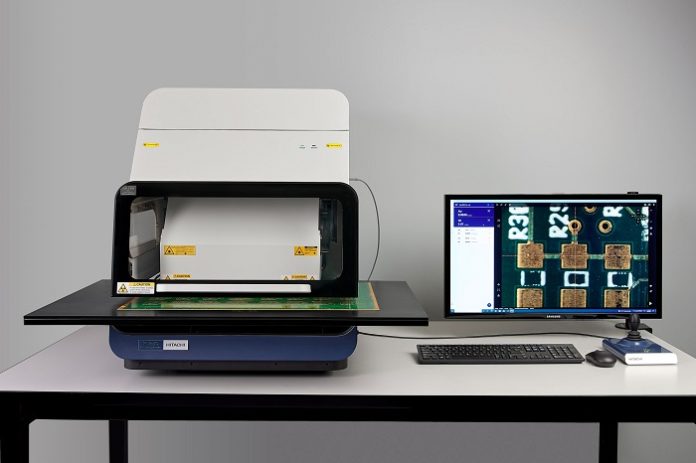Coatings testing for the electrical and electronics industry in India is gearing up for a transformation as coatings analysis becomes critical throughout virtually every component of an electric device.
Hitachi High-Tech Analytical Science, a global company within Hitachi High-Tech Group, has expanded its plating and coatings analysis range with the launch of the breakaway FT230. The new FT230 is designed to enable quality control to keep pace with production by significantly simplifying and accelerating the testing of components and assemblies.
Matt Kreiner, Hitachi High-Tech’s product manager for their coatings analysis product line, had an insightful discussion with ELE Times Sub Editor Mayank Vashisht on how Hitachi is helping to find new solutions to the challenges electronics manufacturers face in their everyday work environment and his latest achievement, the launch of the FT230. The FT230 is Hitachi’s newest XRF coatings analyzer that will set a new pace for plating and coatings XRF analysis in the electronics industry. Excerpts:

ELE Times: What changes do you see happening in the Indian electronics market?
Automation or Industry 4.0 is here and growing, with connectivity as the key driver. We are also seeing the need for 100% inspection to drive down operating costs, increase production volumes, and decrease failure and scrap rates.
Automation has been embraced by the coating industry for a long time, but quality control testing is frequently left out of the integration. That is going to be changed as higher production speeds will not allow time for offline testing. Demand in the booming electronics market is outpacing supply, and that situation is expected to continue as more devices are electrified, automobiles become more autonomous, and 5G technology is deployed and fully implemented.
5G may require some fundamental changes to final finishes used by PCB manufacturers to allow devices to operate at the higher frequency bands available to 5G. The metal finishing industry is under pressure from environmental concerns to replace certain coatings that have long been the stalwarts of the plating industry.
We are also seeing supply chains trending toward localized control to be closer to customers to enable businesses to respond to changes in supply and demand quicker as well as create region-specific offerings.
ELE Times: What is Hitachi doing to support those changes?
Our vision is for analytical instruments to have either WIFI, ethernet, USB or 4G/5G functionality enabled, depending on the industrial environment, to provide connectivity as manufacturers move towards smart manufacturing. We are also moving to analyzers having the ability to share and integrate operational technology (OT) data. So, you can integrate your analyzer to process control systems, and enable them to communicate with other machines and resources in your ecosystem. Ultimately, the end goal is to speed up processes, optimize performance, reduce waste, and ensure product quality.
The new FT230 XRF coatings analyzer is at the leading edge of changes we are making to our products to better support the industry. With the FT230, we are finding ways to shorten total measurement times to help with 100% inspection, connect to ERP, MES, QMS and SCADA systems to be ready for integration of hardware and data and design software that can quickly adjust for new coating applications.
We also have a local presence in India so as companies move towards localized control, bringing their testing in-house, we can help companies adopt an approach of trust but verification. Verification will provide reassurance at each stage: incoming inspection (base metal), in-process (production control), final inspection (quality control) but equally at EMS or assembly house, incoming inspection for quality assurance.
ELE Times: Why was the FT230 created?
Matt Kreiner: The FT230 is a chance to draw a line in the sand. Behind us are the traditional ways of using XRF for coatings, and in front of us is the new direction. Our customers – as well as people who use equipment from other providers – are looking for ways to simplify operations and increase testing volumes.
Everyone is under pressure to do more with less, and that includes making more products, faster and ensuring higher quality with less staff that may not have expertise in XRF. There are a couple of ways we saw to do this.
One was to look for better analytical components, and we have utilized that with the latest-generation detector and signal processing technology. That helps, but we found that the aspect of XRF testing that took the most time wasn’t the actual analysis, it was setting up the measurement routine for the part.
Operators walk up to the XRF holding a part that needs to be measured, they look at the software and have to make a lot of decisions, e.g., how to position the part, where to take measurements, what calibration should be used, what working distance is appropriate and how long of measurement is good enough.
We knew if we could reduce those decisions and automate the measurement routine, we could get operators on and off the XRF quicker, save a lot of time and avoid mistakes at each of those decision points.
ELE Times: How was the FT230 developed?
Matt Kreiner: Before we had any features designed, we conducted the largest voice of customer (VoC) exercise that we have ever done with the industry. We visited plating shops around the world with the R&D and design teams asked questions and just listened to what users wanted and needed.
We took all of those inputs, along with the feedback we have collected over decades of experience with the industry and created our vision of a product that would address those wants and needs. The project team is based in our XRF technology centre in Espoo, Finland and is supported by our global team.
The team designed the internal electronics and mechanics, the look of the instrument and the software. Every aspect of the product has been tested, improved, validated with user feedback, and iterated to create the best user experience on the market.
ELE Times: What excites you most about the FT230?
The look and feel of the software are completely inverted from what is on the market today, including our own products.
We have focused on making life easier for operators and shortening the analysis path from unknown to fully quantified so production lines can be monitored and adjusted much more efficiently. Instead of a screen cluttered with controls and settings crammed next to the camera view and results display, we have made the camera view the largest focal point of the software, followed by the results pane.
The clarity of the camera, aided by the improved LED lighting, is adjustable by rings, wedge segments and individual LEDs. The results pane is large, sharp, and easy to read, with each result card expandable to show even more details of the measurements.
The Find My Part routine feature uses machine vision. The FT230 makes quick work of the lengthiest and most challenging aspect of XRF measurement – setting up a measurement. Initial feedback from customers has been incredibly positive, and I enjoy watching people react to the instrument.
The data handling capabilities are ready for Industry 4.0. You can instantly get results to where you need them with Hitachi’s FT Connect software. The results can be exported in a spreadsheet or comprehensive JSON format for integration with SCADA, QMS, MES or ERP systems. Customized reports can similarly be created for internal or external customers. Diagnostics data can be shared directly with Hitachi’s technical support team over ExTOPE Connect, Hitachi’s cloud-based data management solution.
ELE Times: Where does the FT230 fit in with the rest of Hitachi’s coatings XRF solutions?
Hitachi has a range of XRFs for coatings analysis, including models like the X-Strata920 and FT160, which are purpose-built for the coatings market, and our handheld X-MET8000 which measures coatings and materials including metal alloys. In both feature set and pricing, the FT230 sits between our basic X-Strata920 and our high-end FT160 which includes capillary optics for measuring nanometer-scale coatings on features smaller than 50 µm.
The FT230 is our first product running the new FT Connect software, so it has some new features that are not present on any of our other products. Beyond XRF, Hitachi has a line of electromagnetic gauges for measuring the thickness of paint, anodizing and PCB copper for both surface and thru-hole technologies.
ELE Times: How do Hitachi’s coatings analyzers support Indian electronics businesses?
Hitachi’s coatings products are incredibly capable, reliable, and easy to use. We have solutions for measuring simple coatings on flat parts and complex coatings on parts with varying geometry, and we have products for measuring the thinnest coatings on tiny features. Having products is only one part of the equation though.
We have a global team of technical support and applications experts that is eager to work with our customers to tackle their challenges today and as new ones come up. Our customers also value the fact that coatings analysis is just one issue that Hitachi can address. They will have access to all that Hitachi has to offer – thermal analysis equipment for physical properties testing, scanning electron microscopy for fundamental evaluations and failure analysis, equipment for analyzing contaminants in plating baths and many more instruments and services.
It is an exciting time in the industry, and we are thrilled to partner with our customers to tackle these challenges together.
Mayank Vashisht | Sub Editor | ELE Times








